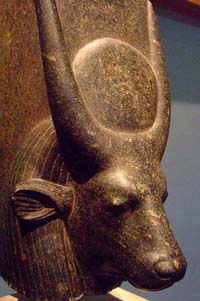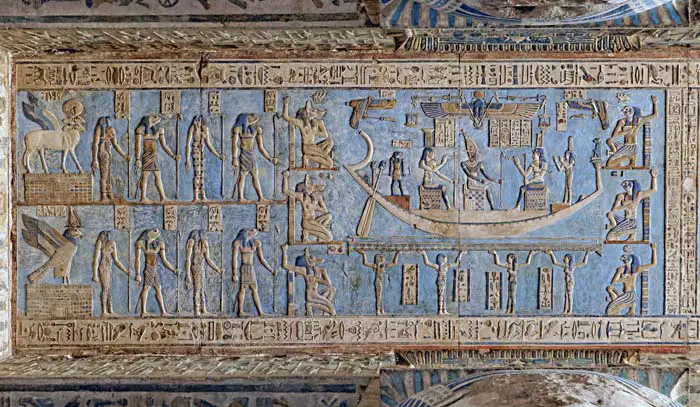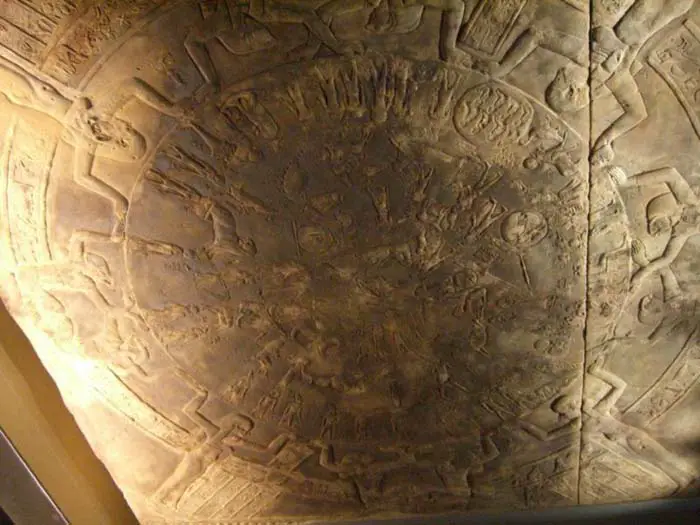Hathor | Goddess of Love and Motherhood
Hathor was one of the most popular deities in ancient Egypt, worshiped by everyone from the pharaoh to commoners. The origins of her cult are unknown but scholars believe her worship began before the beginning of the dynastic period. She was the ancient Egyptian goddess of love and the Greeks associated her with the goddess Aphrodite. Hathor personified joy and motherhood as well as love.
She was the goddess of dance, foreign lands and music as well as being the patron goddess of miners. Hathor was the fertility goddess who helped women in childbirth. The Egyptians associated Hathor with the Milky Way which they called the Nile of the sky. They also called her the “Mistress of the West” and believed she welcomed the dead into the Tuat.

© Jan - Hathor
Hathor’s depictions usually show her as a woman wearing a headdress, which was also her primary symbol. The headdress had two horns with a sun-disc encircled by an uraeus (divine cobra) between the horns. Goddesses associated with Hathor, such as Isis, wear this headdress. Hathor was also a cow goddess and her depictions show her as a cow or a woman with a cow’s head. Her animal appearance referred to the role she sometimes took in Egyptian mythology.
In some myths, Hathor was the divine cow who gave birth to the world and some gods. Some Egyptian depictions show Hathor holding up the sky as a sky goddess. In this form, her legs were the four pillars that held up the sky. Some legends say that Hathor was Ra’s eye and some associate her with the goddess Sekhmet.

© Mary Harrsch - Hathor
These stories say that Hathor became enraged because of Ra’s mistreatment by the Egyptians. She transformed into Sekhmet and began destroying the people of Egypt. The other gods tricked her into drinking milk and she changed back into Hathor.
Hathor’s family tree differs depending on different legends. Egyptian mythology refers to her as Ra’s mother, his daughter and his wife. Some legends claim that Horus was the son of Hathor, not Isis. Hathor was also the consort of Horus and formed a Triad with him and their son Ihi.
Dendera
The Egyptians referred to Hathor as the “Mistress of Dendera” which was the center of her worship. Dendera was the capital of the 6th Nome (province) of Upper Egypt. The temple complex is one of the best preserved in Egypt and covers 40,000 square meters. A mud-brick wall surrounds the sacred space.

© Norman Walsh - Dendera Temple
The present buildings date to the Ptolemaic and Roman periods but fragments of older buildings exist on the site. Some foundations date to the reign of King Khufu, the builder of the Great Pyramid. Egyptologists have cleaned the soot off of the ceiling of one of the main halls. This revealed some of the best preserved ancient paintings discovered to date.

© kairoinfo4u - Dendera Temple, astronomical ceiling at the Pronaos
The temple precinct includes buildings other than the temple of Hathor. There were a series of chapels dedicated to other gods and goddesses, including one to Osiris. Egyptologists found a sacred pool and a birth house in the temple. Dendera has a necropolis containing burials dating from the Early Dynastic Period to the First Intermediate Period.
Dendera Zodiac
One amazing find at Dendera came from the ceiling of the Osiris Chapel and Egyptologists named it the Dendera Zodiac. This zodiac is unique because it is round instead of rectangular. It is a map of the sky and includes the signs of the zodiac, numerous constellations and two eclipses. Some scholars have used the map of the eclipses to date the zodiac to around 50 B.C. but others believe it is older. When it was first made, the zodiac was brightly painted.

© zeevveez - Dendera Zodiac
Many of the zodiac images are the same as those used in Greece. These include Taurus, the bull, and Libra, the scales. One difference is that the Egyptians did not use the sign Aquarius; instead they substituted Hapy, the god of the Nile. The stars were important to the Egyptians because they determined the beginning of the year using Sirius, the Dog Star. Their calendar was lunar not solar.
Important Facts
- Hathor was the goddess of love, joy and music.
- Egyptians from every level of society worshiped her.
- Other goddesses, including Isis, were often associated with Hathor.
- Her largest temple was at Dendera, the center of her worship.
- The Dendera Zodiac, found in a chapel in Hathor’s Temple, is an ancient star map.


